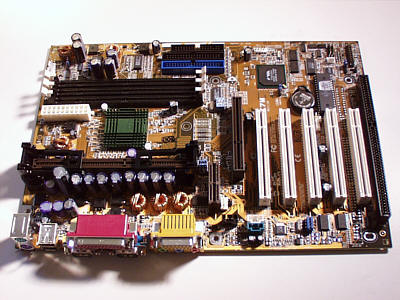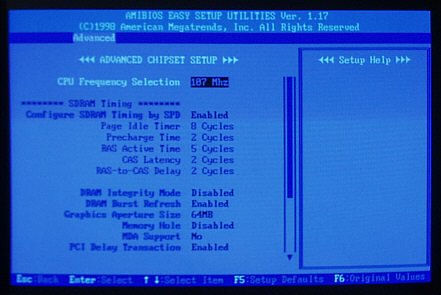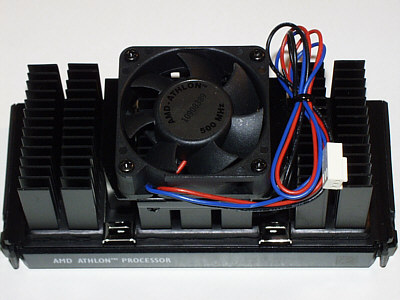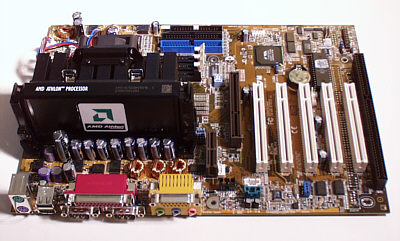
There has been a shortage of good quality of Slot-A motherboards
for the Athlon processor since it was released several months ago.
But this situation is slowly ending as more manufacturers get Slot-A
motherboards to market.
The Asus K7M: The Asus K7M
motherboard is a good example of the new breed of higher-quality Athlon
mainboards that are becoming available. The board has 4
USB ports, 1 AGP slot, 5 PCI slots, 1 ISA slot, 1 Audio/Modem Riser slot,
audio input and output jacks, a joystick port & 3 DIMM slots.
The hard drive controllers have support for ATA/66 drives. Support
for 4 USB ports is afforded by a small I/O card that connects to the
motherboard with a data cable. The I/O card is then secured in the
back panel slot where an Audio-Modem Riser (AMR) card would
go.
The capacitors along the Slot-A socket on the K7M are large, a sign of a good, stable
motherboard. The "northbridge" chipset is the AMD-751,
while the "southbridge" chipset is VIA's VT82C686A. The
AMD-751 northbridge supports up to 768MB of PC-100 SDRAM support.
With the overclock settings, you get unofficial support for PC-133
SDRAM. The chipset supports AGP 1x and 2x standards, but not AGP 4x.
According to Asus, the optional items on the K7M include:
- Built-in Audio
- Infrared Interface
- PC Health Monitoring
- Additional USB ports
The motherboard we received had
the two additional USB ports, and the built-in audio, but not the IR
interface or health monitoring cable. It came in a plain white box,
and the label said "Asus Slot A w/sound ATX". The part
number is "K7M/500/WA".
While the K7M's AMI BIOS was not
quite as convenient as Abit's Softmenu III, it had plenty of setup
options. You can control virtually all aspects of memory timing and
bus frequency.

The manual for the K7M was very good,
almost as good as an Abit manual, but not quite as comprehensive.
Overall, this is the best Athlon motherboard we have seen yet.
The Athlon 500MHz processor: The
500MHz Athlon is selling at a very affordable price, between $20 and $30
less than Intel's Pentium III 500 processor. The cost of the Asus
K7M makes up for this difference, costing about $30 more than a good
quality BX-chipset motherboard. So price is not really a factor in
choosing between the Athlon and Pentium III.

The retail Athlon comes with a very large
heat sink, and a good, high speed fan already installed. The heat
sink is several times more massive than the heat sink on the retail
Pentium III. Setting up an AMD Athlon system was exactly like
setting up an Intel Pentium III system. The only difference was that
there were two drivers for Windows 98 on the Asus CD which had to be
installed to get everything to work. So for those Intel fans out
there who have been wondering if setup for the Athlon was more involved,
the answer is really no. Setting up an Athlon system is as easy as
setting up a Pentium III system.

The Asus K7M allows overclocking in 1MHz
increments between 100MHz and 133MHz. We tested front side bus
settings starting at 105MHz. The system was stable until we got to
108MHz, and which point the system hung in Windows. Setting the
system back to 107MHz allowed testing with complete stability. The
Athlon system booted quickly, being ready to go in about 45
seconds.
Before we do the benchmarks, let's take a
look at the Intel 533B Pentium III with a 133MHz front side bus.
The Intel 533B,
133MHz-bus Pentium III: The oddest part about the Intel 533B
CPU is that Intel does not offer any motherboard support for PC-133
SDRAM. That's correct. They have released a processor for
which they have no compatible motherboard. Intel motherboards only
offer support for PC-100 SDRAM, or Rambus DRAM, but not PC-133
SDRAM. And Intel motherboards do not have any overclocking
capabilities, so you can't run the 533B at 533MHz on Intel's
motherboards. However, companies like Asus and Abit make
motherboards that have overclock settings, including 133MHz on the front
side bus.
Intel
has only released a single variety of processor that uses a 133MHz-bus
which is based on the older Katmai-core. The so-called "Pentium III
533B" has a 4X multiplier setting, and a 133MHz bus setting for a
final speed rating of 533MHz (4 X 133MHz = 533MHz). In Intel's new
nomenclature, the "B" refers to a processor that runs with a
133MHz front side bus (FSB) frequency. All higher speed "B-type"
Pentium IIIs are based on the new "Coppermine" core. The
Coppermine CPUs are built using a newer fabrication process (0.18 micron)
which lets them run on lower power, resulting in less heat
production. Therefore, Intel can set the bus and multiplier settings
higher on these CPUs than with the older "Katmai" Pentium IIIs
(0.25 micron fabrication).
However, 533MHz is well within the
operational range of the Katmai-core, so if the multiplier is set low
enough (4x), then the bus frequency can be increased to 133MHz without
risking instability. This explains why Intel did not bother with
higher speed "B-type" Pentium IIIs using the Katmai chip. They
probably noticed too many Katmai chips failed at 600MHz with a 133MHz bus
setting (4.5 x 133MHz = 600MHz)
We tested the 533B on an Abit BE6
motherboard with 128MB of Siemans PC-133 SDRAM. The setup was very
stable running with a 133MHz bus setting. The motherboard automatically
applies bus frequency dividers to the AGP and PCI slots when the FSB
setting is increased to 133MHz or higher. So when set at 133MHz on the
front side bus, the AGP slot still runs at the normal 66MHz, and the PCI
slots at a normal 33MHz.
AMD vs. Intel...
The Slug Out: We set the Athlon on the K7M at 5 x 107MHz
= 535MHz, and the Intel 533B on the BE6 at it's default setting (4 x
133MHz = 533MHz). The reason for comparing the 533B with the Athlon
500 running at 535MHz is that the Athlon has a faster CPU bus than the
Intel chip (200MHz). So we felt that using an Intel chip with a bus
speed of 133MHz would give a more fair comparison.
As a side note, the front side bus on an
Athlon motherboard is divided into more parts than on a Pentium III
motherboard. The Athlon itself is running at 200MHz, but the memory
bus is still running at 100MHz. The bus setting you change in the BIOS on
the K7M is the memory bus frequency. This means that when the memory bus
frequency is set to 107MHz, the CPU bus is running at 214MHz.
There was no need to do an exhaustive
comparison of these CPUs, they have been compared in detail elsewhere on
the web. But we wanted to give you a quick idea of how they stacked
up to each other. For the Direct 3D benchmarks, we used the Diamond
Viper V770 Ultra TNT-2 video card and 3D Mark 99 Max. For Windows
performance, we used Winbench 99.
Benchmarks:
3D Mark 99 Max (average
of 4 runs):
Athlon @
535MHz PIII
533B @ 533MHz
10011 CPU 3D marks 8385
CPU 3D marks
5331.5 FPU 3D marks 5304 FPU 3D
marks
The Athlon has a 19% better CPU benchmark score,
and a virtually identical FPU benchmark score while rendering Direct 3D
images in 3D Mark 99 Max.
Winbench 99 (average
of 4 runs):
Athlon @
535MHz PIII
533B @ 533MHz
50.175 CPU
marks 40.97 CPU
marks
2917.5 FPU
marks 2710 FPU
marks
This shows a 22% higher score on the CPU business
benchmark, and a 7.6% higher score on the floating point math benchmark
for the Athlon processor.
While the CPU benchmarks are clearly higher
for the Athlon than the Pentium III, the floating point math unit
benchmarks are nearly the same.
Conclusions:
The Athlon is a superior processor to the Intel Pentium III. The
Athlon is a 7th generation processor, while the Pentium III is sixth
generation, and has the same core architecture as the Pentium Pro
processor from back in the early 90's. However, Intel has made some
improvements to the Pentium III with the newer Coppermine version.
These newer Pentium III processors rival the Athlon in business and gaming
benchmarks, and beat the Athlon in some high-end applications like
Photoshop. The only problem is, that Intel made serious mistakes in
getting motherboard support for the Coppermine-type Pentium IIIs to
market, so that currently, it's nearly impossible to find good
motherboards for these new Intel chips. This is similar to the
situation AMD was in with the Athlon right after it's release. The
Athlon is a major step forward for AMD, and gives Intel some hot
competition for the first time in years. Right now, the Athlon is a
better CPU than the original Pentium III, and has better motherboard
support than the Coppermine Pentium III.
While we were only able to overclock the
Athlon 500 by 7MHz on the front side bus, there are reports of much better
results with the newest batch of Athlon CPUs. Also, there are many
reports of the Athlon being very overclockable by changing the multiplier
setting, which requires either an add-on dip switch card, or some
soldering on the circuit board. We will have a report on this soon.
The Asus K7M is a great board for
overclocking the Athlon processor using higher bus settings. The bus
settings range from 100 - 133MHz in 1MHz increments, and there are also
settings of 140MHz and 150MHz. The motherboard has good ATA/66 drive
support, but we would have preferred HighPoint Technologies controller to
the one integrated into the VIA southbridge chipset. Also, there is
no reason to incorporate a sound chip on the motherboard, and we don't
think high-end motherboards need an audio-modem riser slot either.
The 533B version of the Intel Pentium III
is the least overclockable Pentium III ever made. This is because
Intel has already overclocked it as far as it will go. Don't buy
this one unless you want to pay Intel to do your overclocking for you.
Pros:
- The Athlon beats the Pentium 3 by about 20%
- The Athlon overclocks nicely
- The K7M motherboard has great overclock settings
- The K7M has 4 USB ports
- The K7M is stable at high speeds
Cons:
- Built-in Audio on K7M is undesirable on a high-end motherboard
- Audio-modem riser slot is not needed on a high-end motherboard
- K7M is more expensive than BX motherboards
- The Intel "533B" can not be
overclocked further
Note: The Intel 533B was quite stable at 133MHz, indicating that Intel
could have done this with their Katmai-core CPUs much earlier if they had
wanted to. But this is the limit on the bus setting for this core,
so this chip is maxed-out. It's not for overclockers!
- Rating K7M: 4.5 out of 5 smiley faces
:)
:) :) :) +
Availability: Low
- Rating Athlon 500MHz: 5.0 out of 5 smiley faces
:)
:) :) :) :)
Availability: Good
- Rating Intel 533B: 2.0 out of 5 smiley faces
:)
:)
Availability: Good
|